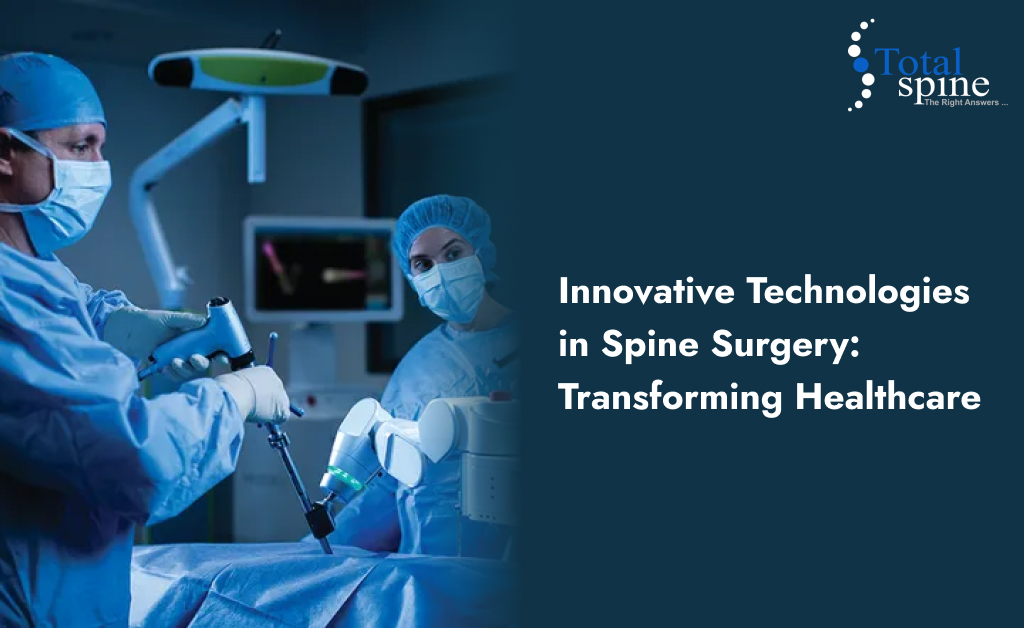Are you still afraid of Spine Surgeries? Are you aware of the advancements in Spine surgery? Keep your worries away and get to know how Spine Surgery in Chennai has undergone a revolutionary change with developments in medical technology that have improved accuracy, patient outcomes, and safety. These ground-breaking medical innovations have changed the way healthcare is delivered and given doctors effective tools to treat spinal disorders. Total Spine intends to talk about spine surgery innovations, few of the state-of-the-art techniques for spine surgery and how they significantly improve patient care.
Robotic-assisted Spine Surgery:
Robotic-assisted surgery is one of the most amazing technical developments in spine surgery. Unprecedented levels of accuracy and control are now available to surgeons because of robotic equipment like the da Vinci Surgical System. Through the use of real-time imaging, preoperative planning, and intraoperative guiding, these technologies enable surgeons to carry out intricate surgeries with increased accuracy and less intervene.
Smaller incisions, less blood loss, shorter hospital stays, and quicker recovery times for patients are all made possible by robotic spine surgery. Throughout the surgery, the surgeon is in charge, and the robotic system acts as a precise extension of their motions. By boosting patient happiness, lowering risks, and improving results, this technology has completely changed how spine surgeries are performed.
Navigation Systems:
The use of navigation technology in contemporary spine surgery is becoming essential. The patient’s spine is mapped out in three dimensions using navigation systems, which make use of cutting-edge imaging technologies including fluoroscopy and intraoperative CT scans. These maps give surgeons real-time input during surgery, allowing them to see where surgical tools are located in relation to the anatomy of the patient. Navigation systems help with accurate screw trajectory, alignment verification, and precise implant placement.
They increase surgical precision and lower the possibility of complications. With the use of guidance technology, surgeons may complete difficult procedures like deformity repairs and revision operations with the best possible results. Improved surgical planning, intraoperative guiding, and postoperative evaluation are made possible by this technology, which ultimately benefits patients by lowering surgical risks and enhancing outcomes.
3D Printing and Patient-specific Implants:
The manufacturing of patient-specific implants for spine surgery has changed dramatically with the introduction of 3D printing technology. Surgeons can now design implants specifically for each patient’s individual anatomy. The creation of exact 3D models from high-resolution images allows for the 3D printing of actual implants. Implants made specifically for a patient give a perfect fit, lowering the possibility of implant failure and enhancing overall stability.
Additionally, 3D printing enables thorough preoperative planning and enhances surgical results by enabling surgeons to produce patient-specific surgical guidelines and models. The field has undergone a revolution because of this technology, which has improved implant design, customisation, and surgical accuracy. Improved implant integration, less problems, and better long-term results are to the patients’ advantage.
Endoscopic and Minimally Invasive Techniques:
Spine surgery has been altered by endoscopic and minimally invasive procedures that minimise tissue damage and enhance patient recovery. In these cutting-edge methods, the spine is accessed through tiny incisions using specialised tools and high-definition cameras. Endoscopic and minimally invasive surgical procedures have several benefits over open surgery, including less muscle injury, less scarring, less blood loss, and quicker recovery times. Patients might enjoy shorter hospital stays and reduced postoperative discomfort.
For ailments including herniated discs, spinal stenosis, and degenerative disc disease, these treatments are very helpful. Now, Spine Surgery in Chennai is pretty common and surgeons are able to carry out delicate surgeries with accuracy and the preservation of the healthy tissues around them with the use of cutting-edge visualisation and specialised tools. By reducing trauma and maximising patient comfort, endoscopic and minimally invasive procedures have revolutionised spine surgery.
Artificial Disc Replacement:
Innovative technique called artificial disc replacement strives to preserve the spine’s mobility and flexibility. In this operation, an artificial disc implant is used to replace a damaged or degenerative disc. Patients are able to preserve normal spinal motion and lower their risk of neighbouring segment degeneration because of artificial discs, which are created to imitate the natural biomechanics of the spine.
Artificial disc replacement has a number of benefits over conventional spinal fusion surgery. It keeps the treated level’s mobility intact, lessening the burden on other discs and perhaps delaying further degeneration. For some individuals, particularly those with single-level disc disease and minimal instability, this novel method offers a workable option. Artificial disc replacement has revolutionised spine surgery by providing better functioning and requiring less nearby disc replacement.
Post Surgery Care:
After having spine surgery, it’s essential to look after your body and develop lifestyle practices that promote recovery and sustain overall wellness.
Follow post-surgery instructions: Strictly follow your surgeon’s post-operative instructions and suggestions. This may require restrictions on lifting, physical activity restrictions, and wound care recommendations. These guidelines should be carefully followed in order to enhance healing and lower the possibility of problems.
Gradually increase physical activity: Start out slowly and work your way up as your healthcare physician approves. Exercises that are low-impact and help you build muscle without placing too much stress on your spine include walking, swimming, and stationary cycling.
Strengthen your core muscles: Increasing the strength of the muscles that surround your spine can add to its stability and support. Develop a core-strengthening routine with the help of a physical therapist that focuses on your pelvic, back, and abdominal muscles. Exercises with significant impact or heavy lifting should be avoided, especially in the first phases of recuperation.
Follow up with healthcare providers: Attend each and every one of your surgeon’s and physical therapist’s planned follow-up visits. They may monitor your development, offer advice, and modify your rehabilitation plan as required.

Conclusion:
Thus, the innovative technology developments have transformed Spine Surgery and allowed surgeons to provide patients with safer, more precise, and efficient treatment options. Navigation systems, 3D printing, endoscopic surgeries, and artificial disc replacement are just a few of the amazing innovations that are transforming healthcare. These developments have improved patient outcomes, modernised surgical precision, and accelerated recovery. The level of care for patients with spinal diseases keeps increasing as a result of the addition of new instruments to Spine Surgery in Chennai, Consult now which improves patient care to a whole new level.

